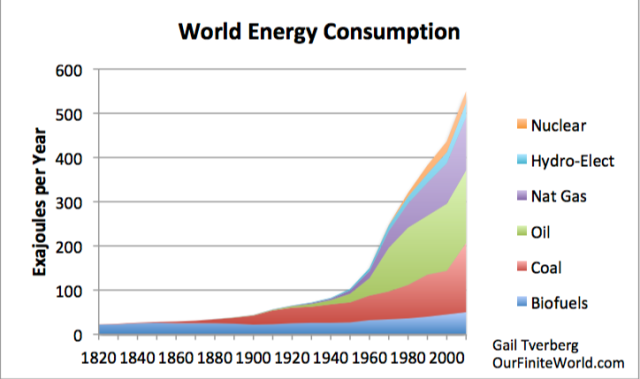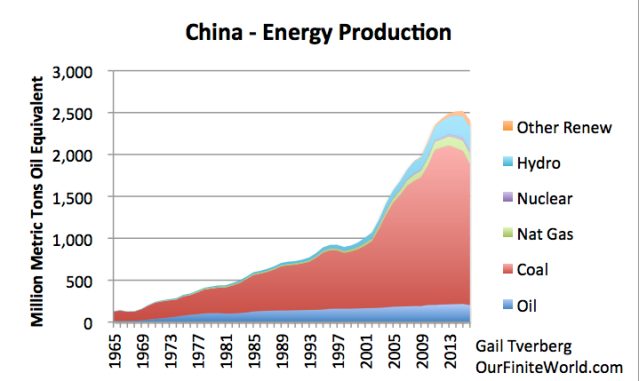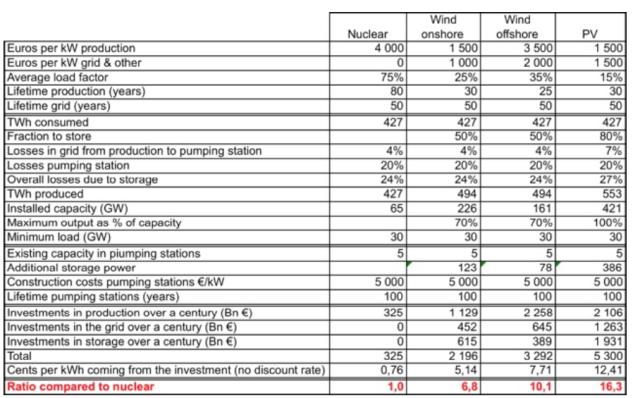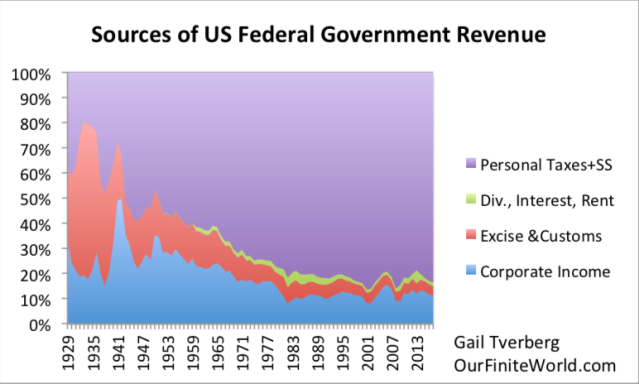By Gail Tverberg
Reading many of today’s energy articles, it is easy to get the impression that our energy problem is a quality problem—some energy is polluting; other energy is hoped to be less polluting.
There is a different issue that we are not being told about. It is the fact that having enough energy is terribly important, as well. Total world energy consumption has risen quickly over time.

Figure 1. World Energy Consumption by Source, based on Vaclav Smil estimates from Energy Transitions: History, Requirements and Prospects and together with BP Statistical Data for years 1965 and subsequent.
In fact, the amount of energy consumed, on average, by each person (also called “per capita”) has continued to rise, except for two flat periods.

Figure 2. World per Capita Energy Consumption with two circles relating to flat consumption. World Energy Consumption by Source, based on Vaclav Smil estimates from Energy Transitions: History, Requirements and Prospects (Appendix) together with BP Statistical Data for 1965 and subsequent, divided by population estimates by Angus Maddison.
There is a good reason why energy consumed has risen over time on a per capita basis. Every human being needs energy products, as does every business. Energy is what allows food to be cooked and homes to be heated. Energy products allow businesses to manufacture and transport goods. Without energy products of all kinds, workers would be less productive in their jobs. Thus, it would be hard for the world economy to grow.
When energy consumption per capita is rising, it is easy for workers to become more productive because the economy is building more tools (broadly defined) for them to use, making their work easier. Manufacturing cell phones and computers requires energy. Even things like roads, pipelines, and electricity transmission lines are built using energy.
Once energy consumption growth flattens, as it did in the 1920-1940 period, the world economy is negatively affected. The Great Depression of the 1930s occurred during the 1920-1940 period. Problems, in fact, started even earlier. Coal production in the United Kingdom started to drop in 1914, the same year that World War I began. The Great Depression didn’t end until World War II, which was immediately after the 1920-1940 period.
In the 1920-1940 period, many people, especially farmers, were not able to earn an adequate living. This is a situation not too different from the one today, in which many young people are not able to earn an adequate living. Strange as it may seem, this type of wage disparity is a sign of inadequate energy per capita, because jobs that pay well require energy consumption.
The 1980-2000 flat period was in many ways not as bad as the earlier one, because the lack of growth in energy consumption was planned. The United States changed to smaller, more energy-efficient cars in order to reduce the amount of gasoline consumed. Oil-powered electricity generation was taken out of service and replaced with other types of generation, such as nuclear. Heating of homes and businesses was changed to more efficient systems that did not burn oil.
The indirect effect of the planned reduction in oil consumption was a drop in oil prices. Low oil prices adversely affected all oil exporters, but the Soviet Union was especially affected. Its central government collapsed, at least partly because of its reduced revenue stream. Member republics continued to operate, somewhat as in the past. Russia and Ukraine cut back greatly on their industrialization, leading to less use of energy products. Population tended to drop, as citizens found better work prospects elsewhere.
Eventually, in the early 2000s, oil prices rose again. Russia was able to become a major oil exporter again, but Ukraine and other industrialized areas were permanently handicapped by the collapse. Countries affiliated with the Soviet Union (including Eastern European countries, North Korea, and Cuba) found themselves permanently lagging behind the US and Western Europe.
Recently (2013-2017), the world economy seems to have again reached a period of flat energy consumption, on a per capita basis.

Figure 3. Based on data of BP Statistical Review of World Energy, 2017, and 2017 UN Population Estimates.
In fact, in many ways the flattening looks like that of the 1920 to 1940 period. Increased wage disparity is again becoming a problem. Oil gluts are again becoming a problem, because those at the bottom of the wage hierarchy cannot afford goods using oil, such as motorcycles. Young people are finding their standards of living falling relative to the living standards of their parents. They cannot afford to buy a home and have a family. Governments are becoming less interested in cooperating with other governments.
Why is world energy consumption per capita flat, or actually falling slightly, after 2013? The answer seems to be diminishing returns with respect to coal production. Diminishing returns refers to the fact that while at first coal is inexpensive to extract, the cost of extraction rises after the thickest seams and those closest to the surface have been extracted.
A chart of China’s energy production shows how China’s coal production first rose as low cost made its usage advantageous, and then fell due to diminishing returns. China experienced a major ramp-up in coal production after it was added to the World Trade Organization in 2001.

Figure 4. China’s energy production, based on data from BP Statistical Review of World Energy, 2017.
As the extraction of coal progressed, China found itself with many mines with rising production costs. Coal prices did not rise to match the higher cost of production, so a large number of unprofitable mines were closed, starting in about 2012.
A major reason for the flat world per capita energy consumption starting in 2013 is the fall in China’s coal production after 2013. Coal production is falling in quite a number of other countries as well, as the cost of production rises, and as users become aware of coal’s environmental issues. Other sources of energy have not been rising sufficiently to keep total per capita energy consumption rising. A person can see in the China chart that wind and solar production are not rising sufficiently to offset its loss of coal production. (Wind and solar are part of Other Renewables.) This situation occurs elsewhere, as well.
What role do wind and solar play in maintaining world energy supply? The truth is, very little. While a great deal of money has been spent building them, wind and solar together amounted to only about 1% of total world primary energy supply in 2015, according to the International Energy Association.
A major problem is that wind and solar do not scale well. As larger quantities are added to electricity networks, more workarounds for their intermittency (such as batteries and long distance transmission) are needed. Bid prices for wind and solar give a misleadingly low impression of their real cost, unless the projects include many hours’ worth of storage to offset the impact of intermittency.
The key to rising energy consumption seems to be the falling cost of energy services, when efficiency is included. For example, the cost of delivering a package of a given size a given distance must be falling, relative to inflation. Similarly, the cost of heating a home of a given size must be falling. Governments must be able to tax producers of energy products, rather than providing subsidies.
Globalization requires ever-expanding energy supplies to meet the needs of a rising world population. To maintain globalization, we need a growing supply of energy products that are very cheap and scalable. Unfortunately, wind and solar don’t seem to meet our needs. Fossil fuels are no longer cheap to extract, because we extracted the resources that were least expensive to extract first. Our problem today is that we have not been able to find substitutes that are sufficiently cheap, non-polluting, and scalable.
A Few Related Questions and Answers:
(1) What is the biggest impediment to raising total energy consumption?
We cannot get the price of oil and of other fuels to rise high enough, for long enough, to encourage the production of the fossil fuel supplies that seem to be in the ground. What happens, instead, is that energy prices hit an affordability limit and fall back.

Figure 5. NASDAQ three month price chart for Brent Crude oil. Source: NASDAQ
The recent strike in Brazil over high diesel prices shows the kind of issues that occur. Oil prices are still far below what many oil exporters (such as Norway, Venezuela, and Iraq) really need, when needed taxes are included.
Of course, the problem with not being able to get prices high enough also discourages the use of alternatives to fossil fuels, such as wind and solar.
(2) Aren’t wind and solar low-cost approaches?
It is easy to think that wind and solar will be huge improvements over burning fossil fuels directly for fuel, but nearly all of these analyses overlook the problems that are added by introducing intermittency to the electric grid. The assumption was made in early analyses that with enough scale, intermittency in one location would tend to offset intermittency in another location. Also, it was hoped that electricity consumption could be shifted to different times of day.
There have been several recent analyses that look more closely at these assumptions. Jean-Marc Jancovici has shown that if sufficient storage is added for wind and solar to make it “dispatchable,” it takes an order of magnitude more physical resources to produce wind and solar compared to what it takes to produce the dispatchable nuclear electricity used in France. Both have low long-term operating costs. Thus, we would expect the true cost of wind and solar to be far higher than France’s nuclear electricity.

Figure 6. Source: Favorable to all scenario from https://jancovici.com/en/energy-transition/renewables/100-renewable-electricity-at-no-extra-cost-a-piece-of-cake/
Roger Andrews, writing on Euan Mearns site Energy Matters, shows that some recent solar and wind auction prices appear to be far below actual costs, when reasonable minimum cost assumptions are used.
Regarding “Demand Response” as a solution to intermittency, Roger Andrews shows how little time of day pricing for consumers affects consumption curves. It appears that people don’t stop eating dinner after they get home in the evening, no matter how high the cost of electricity is at that time.
Interruptible supply is another way of reducing demand. This link describes some of the issues encountered when interruptible supply was tried on a large scale in California.
(3) Can’t we simply get along using less energy? That is what everyone tells us is possible.
The historical record in Figure 2 doesn’t give much indication that this is possible. Whenever there is even a small drop in energy consumption per capita, it seems to have an adverse effect. On Figure 3, even the small dip in energy consumption per capita in 2008 and 2009 led to a serious recession in many countries of the world.
The people who talk about getting along with less energy haven’t thought through the likely ramifications of this. There would be fewer jobs that pay well, because jobs such as those for construction workers would disappear. The economy would shrink, because of the fewer jobs, in a much worse recession than the Great Recession of 2008-2009.
We know that in past collapses, one of the big problems was inability of governments to collect enough taxes. We would likely encounter the same problem again, if there are fewer people making high wages. Most of the tax dollars for the US Federal Government are paid by private citizens (as income taxes or as Social Security funding), rather than by corporations.
The last year shown on Figure 7 is 2017, which is before the recent corporate tax reduction. This change will tend to shift the burden on Federal Taxes even further in the direction of payroll related taxes.
(4) How about efficiency savings? Can’t efficiency savings fix our problem?
There are two issues involved. If we were really efficient at fuel savings, as we were in the early 1980s, oil and other energy prices would drop dramatically. This would push oil, coal, and gas producers worldwide toward bankruptcy. Governments of oil exporting countries, such as Venezuela and Saudi Arabia, would have difficulty collecting enough tax revenue. They would likely collapse from lack of tax revenue, substantially reducing supply.
A second issue is that historically we have been adding efficiency. In fact, efficiency is what has tended to make fuel more affordable. As noted in the article, energy use could grow, as the cost of energy services fell.

Figure 8. Total Cost of Energy and Energy Services, by Roger Fouquet, from Divergences in Long Run Trends in the Prices of Energy and Energy Services. The cost of energy services combines (a) the cost of energy with (b) the impact of efficiency savings.
Some of the changes we have been making recently go in the opposite direction of efficiency. For example, the recent article, Biggest Ever Change in Oil Markets Could Send Prices Higher, discusses a new regulation requiring the use of low-sulfur fuel oil for ships. Doing this would greatly reduce the quantity of sulfur being released to the atmosphere as emissions. This is not a change toward efficiency; it is a change toward higher cost of production, which is the opposite of efficiency. Regulators plan to use part of our energy supply to eliminate the excess sulfur before the oil is sold.
As undesirable as sulfur pollution is, the problem is affordability and higher cost. Wages are not high enough for workers around the world to afford the required higher cost of food (because food production and transport use oil) to support the new regulation. So, the likely result of the regulation is to push the world toward recession. Beyond a certain affordability point, it is hard to push oil prices higher, because wages don’t rise at the same time.
(5) Could you explain further why flat energy consumption per capita is not sufficient for the world economy–this amount really has to grow?
Perhaps looking at charts of recent trends in energy consumption of a few countries can help explain what happens when overall per capita energy consumption is flat.
Joseph Tainter in The Collapse of Complex Societies explains that economies often use “complexity” to work around problems as they approach resource limits. In the particular version of complexity tried in this case, manufacturing was increasingly globalized. Workers suddenly found themselves competing for wages with workers from much lower wage countries. Wage disparity became more of a problem.
When workers are increasingly poor, they can afford to purchase fewer goods and services. This can be seen in energy consumption per capita data. Figure 9 shows energy consumption per capita for three European countries experiencing difficulties. In all three, energy consumption per capita has been falling for several years. When manufacturing was sent to Asia, workers found themselves earning less, so they were able to purchase fewer goods made with energy products. Also, European products were less competitive on the world market, with the new competition from low-cost markets.

Figure 9. Energy Consumption per Capita for three European Countries, based on BP Statistical Review of World Energy data and UN 2017 population estimates.
The countries that have been able to grow more rapidly in response to globalization (such as those in Figure 10) need to keep up their patterns of growth, or they start encountering financial problems because their prior growth was generally financed with debt. Without sufficiently rapid growth, they have difficulty repaying debt with interest.

Figure 10. Energy Consumption per Capita for five countries that recently have been growing rapidly. Based on BP Statistical Review of World Energy data and UN 2017 population estimates.
Brazil’s energy consumption per capita has recently fallen, and it is encountering severe problems. Argentina is a country with flattening energy consumption growth. China’s growth in energy consumption has slowed as well; we often read statements about its debt problems.
One of the problems that these rapidly growing countries encounter is currency fluctuations. As long as their particular country seems to be growing rapidly, the currency level of their country can remain high, relative to the US dollar or the Euro. But if obstacles are encountered, such as the low price of their major export, or slower economic growth, the currency of the country may fall relative to major currencies.
A falling currency relative to major currencies is a problem for these rapidly growing countries for three reasons. For one, imports become expensive. For another, any debt denominated in a foreign currency (such as the US dollar) becomes more difficult to repay. The reason why this is an issue is because rapidly growing countries often do not find enough credit available locally, so are forced to borrow internationally. A third problem with slowing growth and a falling currency relativity is that it becomes more difficult to attract new investment to the country. Instead, outside investors may decide to leave; they want to seek the next growth opportunity, in different, more rapidly growing country.
Turkey and Argentina both seem to be having problems with their currencies falling relative to the US dollar.
Another issue that makes flat worldwide per capita energy consumption unworkable is “diminishing returns” as resources become depleted. For example, wells for fresh water must be dug deeper, ores of metals include higher percentages of waste materials, and oil wells must be sunk in less convenient locations. These problems can be worked around, but they require increased energy consumption. All of these uses for energy products leave less for the rest of the economy. Thus, if we deduct the extra energy needed to compensate for diminishing returns, what at first looks like flat per capita energy consumption worldwide really equates to declining per capita energy consumption.
(6) Isn’t there anything that we can do to reduce carbon dioxide emissions?
The task of reducing carbon dioxide emissions is much more difficult than it appears to be, because the world economy requires energy consumption in order to operate.
The best thing I can see that an individual can do is reduce his or her consumption of meat and other animal products (fish, cheese, milk, leather). To offset, a major increase should be made in the consumption of vegetables that are filling to eat (such as potatoes, beets, carrots, beans, sweet potatoes, taro root, turnips, and corn). Some of these perhaps can be grown locally. Humans’ use of animal products adds to carbon dioxide levels, partly because of the quantity of food that needs to be grown and transported to feed the animals, and partly because of the direct emissions of some animals (including cattle, pigs, buffalo, chicken, sheep and goats).
In fact, cutting back on highly processed food of all sorts (particularly sugars, high fructose corn syrup, and oils) would seem to be worthwhile, as well. Growing, processing, and transporting the crops used in these highly processed foods all add to CO2 emissions.
Our problem is that we have grown attached to the flavors of these foods, and we have become convinced that they help us grow big and strong. While they may do this, they also set us up for problems in old age. Starchy vegetables have played a major role in the diets of long lived people. We may need to start giving them, and other less processed foods, a more prominent role again.
Gail E. Tverberg graduated from St. Olaf College in Northfield, Minnesota in 1968 with a B.S. in Mathematics. She received a M.S. in Mathematics from the University of Illinois, Chicago in 1970. Ms. Tverberg is a Fellow of the Casualty Actuarial Society and a Member of the American Academy of Actuaries. Ms. Tverberg began writing articles on finite world issues in early 2006. Since March 1, 2007, Ms. Tverberg has been working for Tverberg Actuarial Services on finite world issues. Her blog is http://ourfiniteworld.com where this post originally published.
(This post consists of a short overview article I recently wrote for Transform, a magazine for Environment and Sustainability Professionals, plus six related Questions and Answers.)







